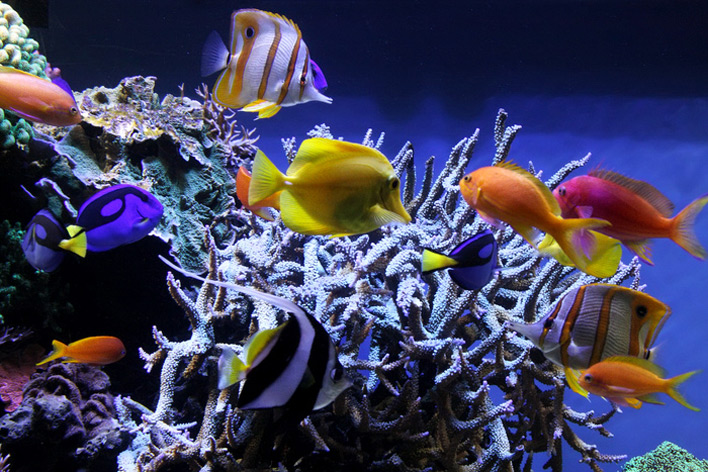Feeding time is one of the most rewarding aspects of keeping saltwater fish. Let’s face it, fish don’t exactly reciprocate affection the way dogs and cats do. The closest we can really get to interacting with them is when we deliver their meals.
Some of the more intelligent species may even learn to recognize and respond to their keeper as the provider of sustenance. In fact, while I can’t swear to it, I’m pretty sure I once overheard the following conversation between the Niger trigger and bird wrasse in my FOWLR aquarium:
NT: “See that rather rotund fellow sitting outside the tank and across the room there?”
BW: “You mean the one clutching the TV remote with one hand and stuffing a pizza slice into his gob with the other?”
NT: “The very same.”
BW: “Yeah, I see him. What’s with that beard?”
NT: “Never mind that now. Be on your best behavior around him. He’s where the food comes from.”
Now, whether that actually happened or was just some feverish hallucination conjured up by my saltwater-addled brain, there’s no question that the manner in which we feed our fish is critical to their health and longevity. Here are several important questions you’ll need to answer as you develop the menu and feeding regimen for your tank’s inhabitants:
Carnivore, herbivore, or omnivore?
Obviously, one of the first factors to consider is whether the natural diets of the species in your care consist primarily of meaty items, algae, or a little of each—in other words, whether your aquatic community includes carnivores, herbivores, omnivores, or some combination thereof. You’ll need to replicate this natural diet to the best of your ability. Be sure to have on hand appropriate foods for every category represented in your tank.
What specific foods should I offer?
Today’s saltwater aquarium hobbyist has more prepared food options to choose from than ever before. A sampling includes:
- Frozen or freeze-dried mysis shrimp, brine shrimp, krill, and plankton
- Special formulations for carnivores, herbivores, and omnivores
- Special formulations for specific families of fish, such as angelfishes, butterflyfishes, and triggerfishes
- Frozen cyclops for feeding the tiniest mouths
- Frozen whole silversides for much bigger mouths
- Frozen chopped clams and squid
- Frozen clams on the half shell
- Dry flakes and pellets of all sizes and for every type of feeder
- Dry green, red, and brown marine algae sheets for grazers
Your local seafood market has plenty of fresh and frozen meaty items for your carnivores/omnivores, as well, such as (raw) table shrimp, scallops, clams, mussels, squid, and, of course, fish. These items can be chopped to an appropriate size or fed whole to larger predatory species. Just be sure to stick to foods of marine rather than freshwater origin.
Also, remember that when it comes to feeding marine fish, variety truly is the spice of life. Lazy feeding, relying on only one or two items, will lead to starved, malnourished fish. Try to rotate as many different items as your fish will accept to ensure that all essential nutrients are provided.
To prevent vital nutrients from being overlooked, it’s a very good idea to occasionally offer dry or frozen foods that have been presoaked in a liquid supplement containing the vitamins and fatty acids essential to the health of marine fish (such as Selcon).
How much and how often should I feed?
Generally speaking, it’s preferable to offer several small feedings per day rather than one heavy feeding. However, the appropriate volume and frequency does vary from species to species.
For instance, zooplankton feeders, such as the popular blue-green chromis (Chromis viridis), tend to benefit from multiple small feedings staggered throughout the day, while many larger predators, such as the various lionfishes and groupers, may need to be fed only every other day or even less frequently. Primarily herbivorous species, such as tangs and rabbitfishes, should be provided something to graze on throughout the day, such as dry marine algae sheets, in addition to their regular feedings.
At each meal, the food you offer should be consumed quickly and completely. No extra food should be left lying around the bottom of the tank to decompose and place an undue burden on your biological filter.
What about live foods?
While there may be instances in which live foods, such as mysis shrimp, brine shrimp, glass shrimp, blackworms, or white worms are necessary to encourage an extremely finicky specimen to start eating, most fish will learn to accept prepared foods, if not immediately after purchase, then in their own sweet time. Your best bet is to start with prepared items and resort to live foods only if all else fails. Offering live foods in steady supply and for the long term can be an impractical and costly proposition. So, if you must start with live foods, do your best to wean your specimens off them as quickly as possible.
WARNING
Under no circumstances should live freshwater feeder fish, such as goldfish or rosy reds, be offered to marine predators. While freshwater feeders typically don’t transmit disease to saltwater species (as they readily do to freshwater species), they are nutritionally inappropriate for marine fishes and have been linked to serious health problems, such as fatty liver disease and gut/intestinal blockages.




Hi
Great site lots of info. I’m just starting on a marine set up.
Was trying to get the free compatibility guide but nothing happens. Did try again but said had to activate. Can you try again please
thanks
Hello!
Fantastic article that needs re-posting to my maintenance clients… may I have your permission to send an email blast to my clients with a link to this article?
Thanks,
Nancy
Hi Nancy! You’re more than welcome to send an email blast to your clients with a link to the article. We greatly appreciate it!
Such a great and informative post. Thanks for sharing and keep posting.